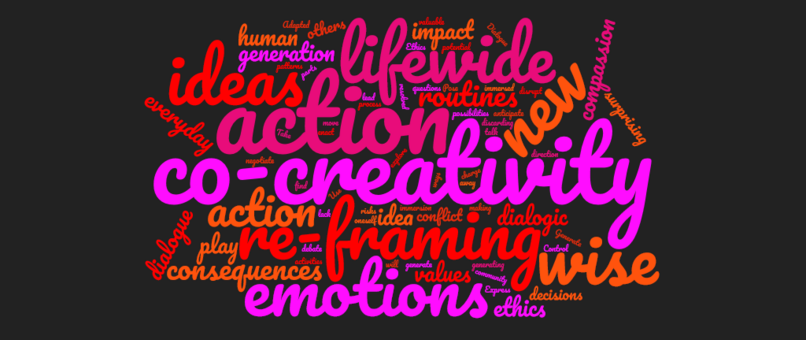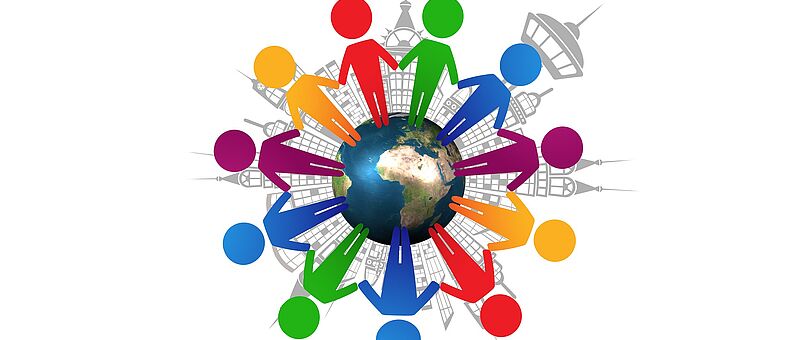Co-creativity is specifically human, lifewide, and happens in and between us. Co-creativity is constituted through individual, collaborative, and communal thinking and action that is wise and humanizing, and evolves through emotive lateral thinking, dialogue, and shared ethics.Co-Creativity involves the following dimensions
• Ethics and impact: Generate, explore and enact new ideas with a valuable impact on the community, discarding other ideas that lack such potential.
• Dialogue: Pose questions, debate new ideas, find ways to negotiate conflict or to go in a different direction to others if conflict is not resolved.
• Control: Take charge of different parts of the creative process, understanding the consequences of decisions, making decisions about new ideas and taking action(s).
• Co-action: Be immersed in classroom activities. Such immersion will sometimes lead to taking risks and generating surprising individual or collaborative ideas and actions.
• Re-Framing: Use the disruptions from games to disrupt the thinking and actions of oneself and others, and so move away from established routines and patterns.
• Emotive Lateral Thinking: Express emotions and talk about how emotions have an impact on one’s ideas and actions, and anticipate emotions and emotional possibilities to generate ideas
Further Readings:
Chappell, K., Walsh, C., Wren, H., Kenny, K., Schmoelz, A., Stouraitis, E., & Agogi, E. (2017). Wise humanising creativity: Changing how we create in a virtual learning environment. International Journal of Game-Based Learning, 7(4), 50–72. https://doi.org/10.4018/IJGBL.2017100103
Schmoelz, A. (2017). On Co-Creativity in Playful Classroom Activities. Creativity. Theories – Research - Applications, 4(1), 25–64. https://doi.org/10.1515/ctra-2017-0002
Schmoelz, A. (2018). Enabling co-creativity through digital storytelling in education. Thinking Skills and Creativity, 28, 1–13. https://doi.org/10.1016/j.tsc.2018.02.002
Stenning, K., Schmoelz, A., Wren, H., Stouraitis, E., Scaltsas, T., Alexopoulos, C., & Aichhorn, A. (2016). Socratic dialogue as a teaching and research method for co-creativity? Digital Culture & Education, 8(2), 154–168.
Schmoelz, A. (2019). Creative Works. In Maria Ranieri, Benjamin Thevenin, & Gianna Cappello (Hrsg.), The International Encyclopedia of Media Literacy (S. 1–9). Wiley-Blackwell.
Schmoelz, A. (2016). Ernsthafte Spiele als Anlass für Ko-Kreativität? In J. Haag Weißenböck, J. ,. Gruber, W. &. Freisleben-Teuscher, C. F. (Hrsg.), Game Based Learning. Dialogorientierung & spielerisches Lernen analog und digital (S. 107–118). IKON.
Schmoelz, A. (2019). Zwischen Individualität und Kollektivität: Relevanz zwischenmenschlicher Beziehungen in der Theorie der Ko-Kreativität. Reflexionen empirischer Ergebnisse aus der Unterrichtsforschung. In H. Fasching (Hrsg.), Beziehungen in pädagogischen Arbeitsfeldern und ihren Transitionen über die Lebensalter (S. 132–150). Julius Klinkhardt.
Schmoelz, A. (2020). Diversität und Ko-Kreativität im Klassenzimmer. In S. Doff & J. Pfingsthorn (Hrsg.), Media Meets Diversity @ School. Wie kann Lernen und Lehren in der digitalen Welt unter den Vorzeichen von Diversität gelingen? (S. 237–255). WVT.
Schmölz, A., Barberi, A., Ollinger, I., & Krause, S. (2017). Kreativität und Ko-Kreativität. Medienimpulse, 55(4), 1–15.
Motschnig, R., & Schmoelz, A. (2018). Creativity in cooperative face-to-face and online settings – What are the criteria that matter?. Medienimpulse, 55(4). https://doi.org/10.21243/mi-04-17-04










